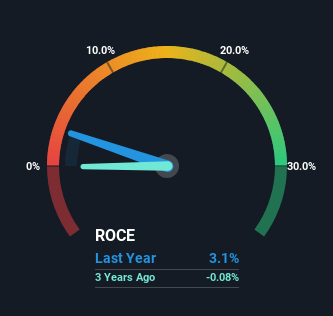- United States
- /
- Electrical
- /
- NasdaqCM:APWC
Asia Pacific Wire & Cable's (NASDAQ:APWC) Returns On Capital Not Reflecting Well On The Business
When researching a stock for investment, what can tell us that the company is in decline? When we see a declining return on capital employed (ROCE) in conjunction with a declining base of capital employed, that's often how a mature business shows signs of aging. Trends like this ultimately mean the business is reducing its investments and also earning less on what it has invested. On that note, looking into Asia Pacific Wire & Cable (NASDAQ:APWC), we weren't too upbeat about how things were going.
Understanding Return On Capital Employed (ROCE)
For those that aren't sure what ROCE is, it measures the amount of pre-tax profits a company can generate from the capital employed in its business. To calculate this metric for Asia Pacific Wire & Cable, this is the formula:
Return on Capital Employed = Earnings Before Interest and Tax (EBIT) ÷ (Total Assets - Current Liabilities)
0.031 = US$7.4m ÷ (US$371m - US$134m) (Based on the trailing twelve months to December 2022).
Therefore, Asia Pacific Wire & Cable has an ROCE of 3.1%. In absolute terms, that's a low return and it also under-performs the Electrical industry average of 11%.
View our latest analysis for Asia Pacific Wire & Cable

Historical performance is a great place to start when researching a stock so above you can see the gauge for Asia Pacific Wire & Cable's ROCE against it's prior returns. If you'd like to look at how Asia Pacific Wire & Cable has performed in the past in other metrics, you can view this free graph of past earnings, revenue and cash flow.
The Trend Of ROCE
In terms of Asia Pacific Wire & Cable's historical ROCE movements, the trend doesn't inspire confidence. To be more specific, the ROCE was 5.2% five years ago, but since then it has dropped noticeably. And on the capital employed front, the business is utilizing roughly the same amount of capital as it was back then. Since returns are falling and the business has the same amount of assets employed, this can suggest it's a mature business that hasn't had much growth in the last five years. So because these trends aren't typically conducive to creating a multi-bagger, we wouldn't hold our breath on Asia Pacific Wire & Cable becoming one if things continue as they have.
The Bottom Line On Asia Pacific Wire & Cable's ROCE
In the end, the trend of lower returns on the same amount of capital isn't typically an indication that we're looking at a growth stock. Long term shareholders who've owned the stock over the last five years have experienced a 27% depreciation in their investment, so it appears the market might not like these trends either. That being the case, unless the underlying trends revert to a more positive trajectory, we'd consider looking elsewhere.
One final note, you should learn about the 2 warning signs we've spotted with Asia Pacific Wire & Cable (including 1 which makes us a bit uncomfortable) .
For those who like to invest in solid companies, check out this free list of companies with solid balance sheets and high returns on equity.
New: Manage All Your Stock Portfolios in One Place
We've created the ultimate portfolio companion for stock investors, and it's free.
• Connect an unlimited number of Portfolios and see your total in one currency
• Be alerted to new Warning Signs or Risks via email or mobile
• Track the Fair Value of your stocks
Have feedback on this article? Concerned about the content? Get in touch with us directly. Alternatively, email editorial-team (at) simplywallst.com.
This article by Simply Wall St is general in nature. We provide commentary based on historical data and analyst forecasts only using an unbiased methodology and our articles are not intended to be financial advice. It does not constitute a recommendation to buy or sell any stock, and does not take account of your objectives, or your financial situation. We aim to bring you long-term focused analysis driven by fundamental data. Note that our analysis may not factor in the latest price-sensitive company announcements or qualitative material. Simply Wall St has no position in any stocks mentioned.
About NasdaqCM:APWC
Asia Pacific Wire & Cable
Through its subsidiaries, manufactures and distributes enameled wire, power cable, and telecommunications products in Thailand, Singapore, Australia, the People’s Republic of China, Hong Kong, and the Asia Pacific region.
Excellent balance sheet and good value.
Market Insights
Community Narratives




